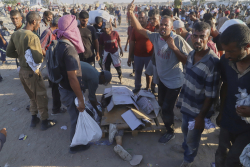The Indian Air Force will soon retire its remaining contingent of Soviet-era MiG-21 fighters after six decades of service.
While New Delhi’s potential procurement of additional Rafales has yet to be confirmed, its air force will certainly benefit from more of the 4.5-generation platform.
While India appeared to have been interested in procuring the Russian-made Su-57 fighter, it looks like the South Asian nation is looking to France to bolster its aerial defenses instead. According to reports, New Delhi will likely place an order for additional Rafale jets from French manufacturer Dassault Aviation. Following its recent skirmish with Pakistan along its shared border, Indian officials recognize the need to ensure the superiority of the Indian air fleet.
This fall, the Indian Air Force will be retiring its remaining contingent of Soviet-era MiG-21 fighters after six decades of service. The delivery of the Rafale jets would help the service replenish its fighter needs in the years to come. India’s decision to forgo acquiring Su-57s falls in line with the nation’s wider pivot away from Russian defense equipment.
In July, Indian defense secretary Rajesh Kumar Singh confirmed that discussions pertaining to the procurement of fifth-generation fighter aircraft were underway. “As far as our steps in this regard are concerned, we are talking to our partners on the fifth generation fighter aircraft program. As of now, those discussions have not reached a stage where we can start sharing this with the media,” he added. “These are sensitive negotiations.” While New Delhi’s potential procurement of additional Rafales has yet to be confirmed, its air force will certainly benefit from more of the 4.5-generation platform.
The Su-57
Designated by NATO as the “Felon,” the Su-57 platform represents Russia’s answer to American-made fifth-generation jets. While the fighter is intended to be a tough counter against the US F-35 Lightning II, production issues and performance questions have undermined the platform’s purported specs and capabilities. The first Felon reached operational capacity in 2020 after nearly two decades in the conceptualization, design, and development phases. While the Russian jet is notably fast on paper, able to fly at a top speed of Mach 2 (times the speed of sound), it lacks the stealth that its American near-peer jets possess. The Felon’s radar cross-section is larger than the F-35 and F-22 Raptor, meaning it is easier for adversarial aircraft and radar to detect. For Russia, the Su-57 represents a significant technological leap when compared to the Soviet-era aircraft its air force typically flies. However, too few Felons have been produced to really pose a true threat to the United States.
The Rafale
Dassault Aviation’s Rafale fighter jet is arguably the most popular aircraft of its kind on the export market today. The platform’s surge in global demand is well warranted, considering the Rafale’s reputation. Featuring a vast array of weapons, this multirole fighter aircraft can perform interdiction, air supremacy, ground support, and a whole host of other missions. In terms of ordnance, the Rafale can fire some of the most lethal arms available. From the Sidewinder, ASRAAM, Magic, and Penguin 3 to the Apache, HARM, ALARM, and Maverick air-to-ground missiles, the French jet would be hard to beat in a dog fight. The Rafale can notably operate from both aircraft carriers and land bases, making it a versatile asset for any air force that flies it.
About the Author: Maya Carlin
Maya Carlin, National Security Writer with The National Interest, is an analyst with the Center for Security Policy and a former Anna Sobol Levy Fellow at IDC Herzliya in Israel. She has bylines in many publications, including The National Interest, The Jerusalem Post, and The Times of Israel. You can follow her on Twitter: @MayaCarlin.
Image: Kostas Alkousis / Shutterstock.com

















